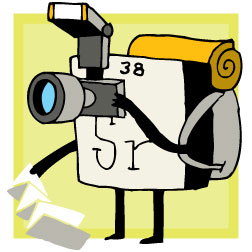Blogging the Periodic Table

Today's post has less to do with the periodic table per se than with people's obsessions with it. I wrote my book partly to help people see beyond the table as just a flat chart hanging on the wall of a science classroom—it intersects with so many areas of life and can be studied on many levels, appreciated in many different ways. At the same time, I never imagined the extent to which some people incorporate the periodic table into their lives.
I first came across Jim Marshall, a chemist at the University of North Texas, while researching strontium—a fairly nondescript element, but one whose discovery I found fascinating. It was discovered in the 1790s in an unlikely setting, a red-light district in London, not far from Shakespeare's Globe Theater. And it was not a scientist but a medical doctor who first isolated it. He was looking for new chemicals to treat patients and employed real chemistry to find strontium—a far cry from the medical quackery so common in the 1700s. What's more, it's one of the few elements named after a place that's not a major research center. It's named for Strontian, a hamlet in rugged western Scotland, where local miners first discovered minerals that contained the element. They were just out to make a living off the land, and certainly had no inkling they'd end up making a mark on science when they started digging.
Marshall pieced together this quirky back story. But as much as anything, I remembered learning that he'd actually visited Strontian—for nothing more than the pleasure and satisfaction of being in the place where an element had been discovered. And he didn't limit his reverence to Element 38. He'd made pilgrimages to chemistry holy sites around the world. Jim and his wife Jenny are probably the only human beings who have visited the location where every single element was discovered. For the past dozen years, the Marshalls have been planning their vacations around the periodic table, visiting cities, villages, mines, and labs in 30 different countries and compiling maps and photographs for a book on what might be called periodic table tourism.
Sometimes their travels looked pretty cushy. They've visited Heidelberg and St. Petersburg and the Louvre (which housed offices before becoming an art museum, including the scientific labs of Antoine Lavoisier, a French chemist who compiled the first official list of elements and who proved that water and air were not elements). But many of the locations the Marshalls traveled to were heroically remote, if not downright desolate—small islands in Scandinavia, or the abandoned Roman-era mine in Romania where tellurium was discovered.
Another person whose love of the periodic table has strayed over into admirable eccentricity is Theodore Gray, a sometime chemist and software developer who lives in Illinois. Gray has made a bit of a name for himself among chemistry types for his willingness both to throw huge blocks of sodium into a pond in his backyard (sodium explodes on contact with water) and then to post videos of the stunt online. He even likes to invite guests sometimes for what he calls "sodium parties."
Other people have been known to have sodium parties too—MIT students traditionally throw a block of the stuff into the Charles River every year during homecoming. What sets Gray and his element fixation apart is his periodic table table —a wooden coffee table that not only is in the shape of a periodic table, but actually contains elements.
Gray designed and hand-carved the table at his home. Each group of elements is represented by a different kind of wood—noble gases are Carson maple, while halogens are Kentucky coffee. And each separate element had its own tile on the surface of the table. The tiles are removable, and beneath each one lies a small alcove. Gray collected samples of every natural element (those up to uranium, Element 92) as well as some of the longer-living synthetic elements (e.g., americium, common in smoke detectors) to store inside the table. Solids like metals could go right in as nuggets or ingots, and gases and liquids went in small vials. Radioactive elements went into lead "cans" that Gray molded himself.
Gray admits he had to fudge things with a few elements. Astatine and francium are so short-lived and scarce—there are only 30 or so grams of astatine on the entire earth—that he obviously couldn't collect samples of them for display. Instead, he put uranium in their place, on the sensible theory that uranium atoms can decay into astatine and francium, so any reasonable sample of uranium is bound to contain a few atoms. (You can buy all the uranium you want, even on Amazon. You just can't buy enriched uranium.) But for the most part, all his samples—gold, arsenic, neon, carbon, etc.—are legit, and his efforts won him the 2002 Ig Nobel Prize, a sort of mock Nobel handed out for scientific work that "cannot or should not be reproduced."
Like Slate on Facebook. Follow us on Twitter.